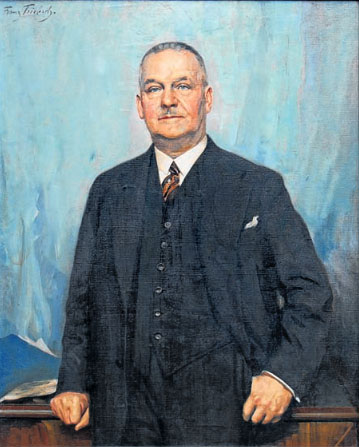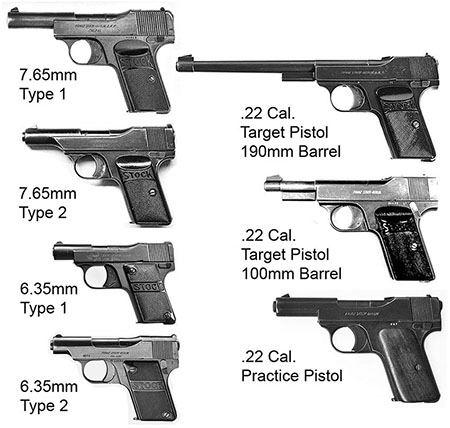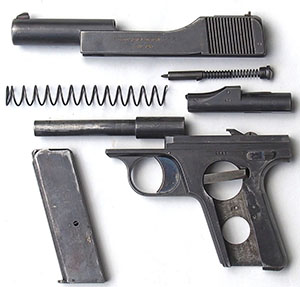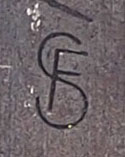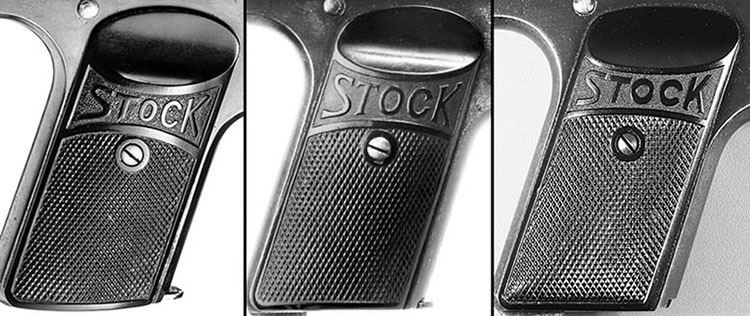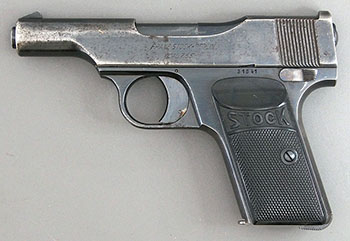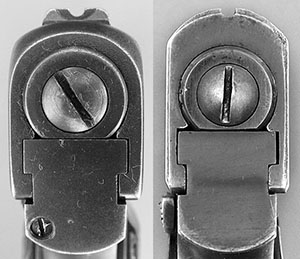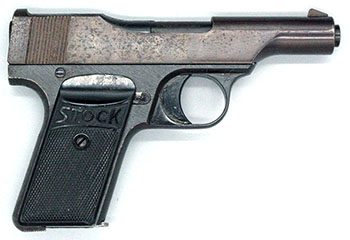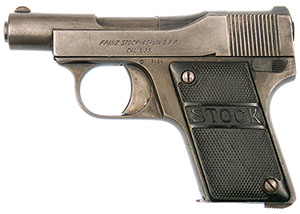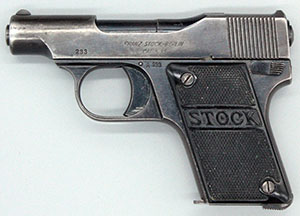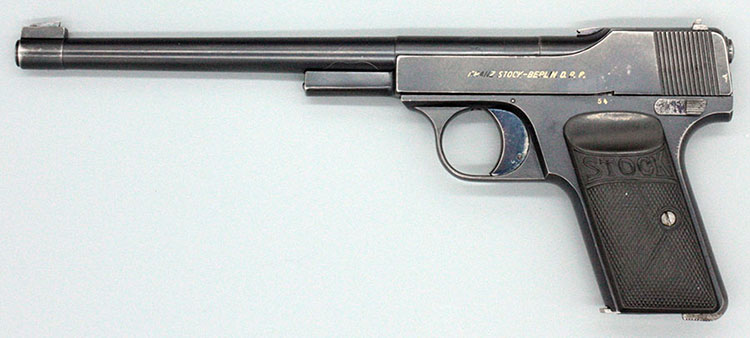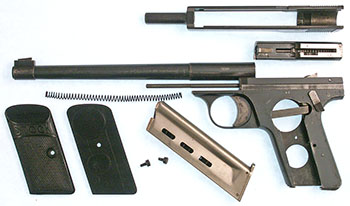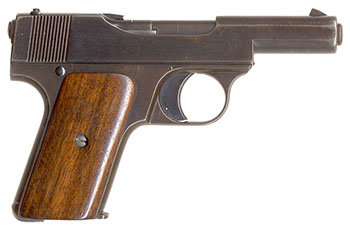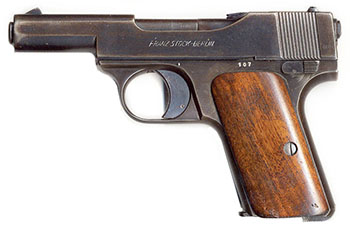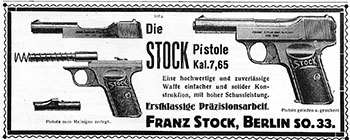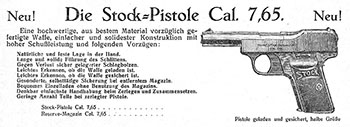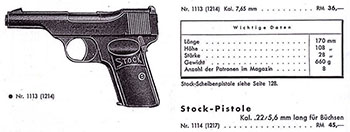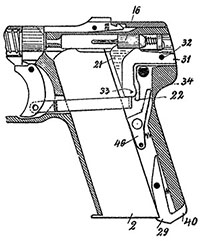 |
|||||||||||||||||||||||||||||||||||||||||||||||||||||||||||||||||||||||||||||||||||||||||||||||||||||||||||||||||||||||||||||||||||||||||||||||||||||||||||||||||||||||||||||||||||||||||||||||||||||||||||||||||||||||||||||||||||||||||||||||||||||||||||||||||||||||||||||||||||||||||||||||||||||||||||||||||||||||||||||||||||||||||||||||||||||||||||||||||||||||||||||||||||||||||||||||||||||||||||||||||||||||||||||||||||||||||||||||||||||
|
The Franz Stock Automatic Pistols by Ed Buffaloe and Ed Dittus Historical Background Verifiable historical information about the Franz Stock company or its products is skimpy at best. A great deal of the information to be found on the internet at this writing is either incorrect or unsubstantiated. One point that is made consistently is that the gun was designed by a Walter Decker.
One or two on-line sources link Walter Decker with the Becker & Hollander company of Suhl, asserting or implying that he was designer of the Beholla pistol. However, it is well known that the Beholla is a copy of the Menz Menta. We cannot speak to any possible relationship between Decker and the Becker & Hollander company, but Decker is certainly not the designer of the Beholla pistol.
The Franz Stock Maschinenbau & Werkzeugfabrik (Franz Stock Mechanical Engineering and Tool Factory) is listed in its German patents simply as “Firma Franz Stock,” from which we derive our usage, “the Franz Stock Company.” We find entries in the Berlin directory for Franz Stock beginning around 1908, listed as a machine and tool factory. In 1920 the listing reads: “Machine and tool factory, precision mass items, weapons, telephone, fittings and metal works.” A 1922 display ad simply reads “Franz Stock - Stock Pistolen.” Beginning in 1935 we begin to see display advertisements featuring thread cutters and chucks, likely an indication that the company business remained primarily machine fabrication and tool making. Listings after 1928 do not include weapons or pistols. There are no listings for Franz Stock after 1946.
There are areas that need further investigation: more information is needed about Franz Stock and his company, and about Walter Decker. What other products did the Franz Stock company make, and what did Walter Decker do after he sold his patents to Franz Stock? Likewise, any information about specific guns that we can add to our database would be most helpful. We would appreciate any information readers might provide .* We develop information regarding the history of the Franz Stock pistol itself in the section entitled “Establishing a Timeline for the Franz Stock Pistols” below. The information in the “timeline” section is critical for some of the conclusions we draw in this article, but the sequence may be difficult to follow if you are not familiar with the pistols themselves, so we have placed it after we describe the pistols. The narrative we have developed leads us to conclude, at least tentatively, that making weapons was a relatively small part of the company business. We estimate that less than 50,000 pistols of all types were made over the course of twenty years. The Design of the Franz Stock Pistol
The Franz Stock pistols are well made and inherently accurate due to their fixed barrel and precision manufacture. The design breaks down into three basic parts: the frame, the slide, and the bolt or breech block. The barrel is fixed to the frame and the recoil spring is concentric around the barrel. Surrounding the breech area of the barrel is a tubular cover for the rear of the recoil spring, so the spring is never exposed in the central opening of the slide. The slide has a tubular front portion that serves as a shroud for the barrel, and a rear portion that connects to the frame rails and serves as a platform to hold the breech block. The breech block contains the top-mounted extractor, the rear portion of which has a hook that connects the breech block to the slide. The breech block also holds the striker and striker spring, which are retained by a threaded plug at the rear. The ejector is press fit into the left side of the frame. A magazine
We have found more than one breech block with the hook on the rear of the extractor broken off. J .B. Wood speculated that this might happen: “...the breech block hook at the rear of the extractor is not liable to breakage in normal use, but could be broken if some ham-handed type attempted to force the breech block forward without first lifting the extractor.” On the other hand, the tail on the extractor has a long thin neck, and breakage problems may be the reason this neck was markedly shortened on later guns--whether due to “ham-handed” shooters or brittle small parts we cannot say.
Manufacture probably began late in 1920 (see the “timeline” section below for details) though prototypes may have been made as early as 1918. The “Service Pistol” designation is a late usage, but derives from the company itself. There are two, possibly three, types of the 7.65mm. Type 1 - 7.65mm
The trigger is of the rotating type that pivots on a pin. The transfer bar is internal on the left side of the gun. The grip plates are of checkered hard rubber with an oval thumb-rest at the top, beneath which is the word “Stock”. Early grip plates have the Stock name in sans-serif characters, but somewhere in the late 5000 serial number range we begin to see serif characters, and the grip plates are slightly thinner. Occasional later guns are seen with the sans-serif grip plates, and a few guns are reported to have mixed grip plates. Type 2 grip plates return to sans-serif characters.
The slide inscription, on the left side, is in all-capital sans-serif italic characters: FRANZ STOCK-BERLIN. D.R.P. We see a very few 7.65mm guns, noted thus far only in the 24000 serial number range, with no caliber designation and no D.R.P. in the inscription: FRANZ STOCK-BERLIN. Very late Type 1 pistols lack the D.R.P. in the inscription, but retain the caliber designation: FRANZ STOCK-BERLIN. “D.R.P.” abbreviates “Deutsches Reichs Patent” and indicates that the designated item is patented in Germany. The Decker patents would have expired in 1934 and 1935, and so it is possible the “D.R.P.” was removed at this time, which would give us a time frame for the late 7.65mm Type 1 pistols. However, at this point the connection with the patent expiration should be considered speculation. The serial number is above the left grip plate, sometimes partially covered by it. The last two digits of the serial number are stamped on the left side of the breech block and on the bottom or front of the slide crosspiece. The finish is blue, with a heat-blue trigger. Magazines are also blued.
At some point the barrel and slide of the 7.65mm pistol were shortened by nearly half an inch, making two minor variations of the Type 1 pistol. This change took place somewhere between serial number 16052 and 18042. The difference is clearly visible in the length of the barrel shroud portion of the slide. Please write to us if you have a gun between these serial numbers so we can determine more precisely when this change happened.* The earliest serial number we have recorded for a 7.65mm Type 1 is 130, and the highest is 24322, indicating that just under 25,000 Type 1 pistols were likely made in 7.65mm. However, there are gaps in our database, and the total may be significantly less. It is possible that the 6.35mm Type I pistols were in the same serial number range as the 7.65mm, but we have assumed, based on all the data we have collected, that they were in separate ranges and our production estimates are predicated on this assumption. Please write to us if you have a Franz Stock pistol that we can add to our database.*
Type 2 - 7.65mm
The grip plates on the Type 2 have a more flattened oval thumb rest at the top that does not cover the serial number. The word “Stock” is once again in sans-serif characters on the grip plates. The slide inscription,
FRANZ STOCK-BERLIN. At some point between 30000 and 32000 the dash was removed between “Stock” and “Berlin” in the slide inscription. In this serial number range both inscriptions may be found. FRANZ STOCK BERLIN. The earliest serial number we have recorded for a Type 2 first variant is 24543 and the highest is 34455. However, we have none recorded in the range between 25000 and 30000, which suggests the possibility that only about 5000 were ever made. However, we must withhold judgment until further data can be collected. Please contact us if you can help.*
The Type 2, second variant pistol has a trigger that slides horizontally, rather than pivoting on a pin, and the transfer bar has been moved to the right side. The transfer bar is visible externally, but is set into the frame with the front portion partially visible just in front of the right grip plate. There is no pin above the trigger. A wire spring has been added to tension the transfer bar upward, and there is a cut near the front of the bottom edge of the transfer bar to allow it room to move down when the bar is depressed by the disconnector. The grip plate, which has a circular boss on the back to position it on the grip, has had the boss relieved to accommodate the transfer bar and spring. No change has been made to the sear or disconnector.
The lowest serial number we have recorded for a confirmed Type 2 second variant is 35025 and the highest is 35310. Thus far, all have been in the 35000 range. At this time we estimate that only about 300 were made, but again more data is needed.* The existence of a third “type” 7.65mm Stock pistol is speculative at this writing, as it may be a one-of-a-kind pistol, possibly a special order. It likely appeared in late 1939 or early 1940, as the single documented specimen has eagle over N proofs. It is said to be the same size as the 6.35mm pistol, but chambered in the larger caliber. We have been unable to confirm widespread use of the 7.56mm “Service Pistol” by police departments or other government agencies. Individual examples have been documented in use by the Münster criminal police, and several by the Düsseldorf criminal police and the Recklinghausen police headquarters, however the circumstances of their use remain unknown to us. Based on inventory numbers assigned, we suspect there are other examples waiting to be discovered.
The 6.35mm pistol appeared sometime in the 1922 to 1923 time frame. The gun is a downsized version of the 7.65mm except the barrel and slide are proportionally shorter, making the gun a true pocket pistol, though slightly larger than what we usually consider “vest pocket” size. The front sight is integral with the front of the slide. The rear sight is also integral--a U-shaped channel in a raised portion at the rear of the slide. The grip plates are checkered hard rubber with the word “STOCK” horizontally about two-thirds of the way up in all-capital serif characters. The grip plates are secured by two screws, one at the top front and another at the bottom rear. Magazines are blued and have the same three vertical slots on the right side and a single small hole on the left, and are stamped on the bottom with a sans-serif F over S. There are two types of the 6.35mm.
Type 1 - 6.35mm The 6.35mm Type 1 is much like its 7.65mm counterpart, with the arms of the slide squared off just in front of the trigger guard. The slide has 13 triangular-cut serrations angled to match the rear face of the slide and frame. The internal function is identical, including the magazine safety. The serial number is on the frame, just behind the trigger and in front of the grip plate. The slide inscription, on the left side, is in all-capital sans-serif italic characters: FRANZ STOCK-BERLIN. D.R.P. The lowest serial number we have recorded for a 6.35mm Type 1 pocket pistol is 329, and highest is 12099, so our estimate is that about 13000 were made. Please write to us if you have a pistol we can add to our database to make this estimate more accurate.*
Type 2 - 6.35mm
The slide inscription, on the left side, is in all-capital sans-serif italic characters: FRANZ STOCK-BERLIN. Again, we observe that on the 6.35mm Type 2 pistol, as on the 7.65mm Type 2, the “D.R.P.” has been omitted from the inscription. The lowest serial number we have recorded for a 6.35mm Type 2 pocket pistol is A5, and the highest is A1973, so we estimate that approximately 2000 were made. Please write to us if you have a Type 2 with a higher serial number.*
In 1914 John M. Browning designed the first self-loading pistol for the .22 long rifle cartridge, and in 1915 the Colt’s Patent Firearms Manufacturing Company began to make this gun, which they called the Colt Target Pistol, later known as the Woodsman. In 1920 German target shooting was still dominated by the single-shot target pistol, but the Colt Woodsman soon made its appearance in Germany and the German firearms industry took note almost immediately. The Franz Stock target pistol was introduced in 1924. It is a little-known fact that the Franz Stock target pistol was the first self-loading target pistol in .22 caliber to be made in Germany. Walther entered the market about two years later. As noted below, the Franz Stock .22 began winning competitions almost as soon as it became available, and in 1928 it won the national championship.
The Target Pistol in .22 Caliber The basic Walter Decker design was retained, but it was given a 190mm (7.5 inch) barrel. The barrel shroud portion of the slide is eliminated because the extra weight is unnecessary for the low-power cartridge, and the lightweight recoil spring is moved to a housing beneath the barrel. The recoil spring shroud is eliminated. The recoil spring guide rod is permanently mounted in the frame. The top-mounted extractor of the original design becomes a take-down lever, and the extractor is moved to the right side of the gun. The ejector was eliminated--the hardened lips of the magazine serve to eject the cartridge. The magazine safety is eliminated. The slide has 13 triangular-cut serrations. Most of the .22 pistols have a crown over B proof, though some of the early guns have crown over N. The finish is blue with a fire blue trigger. The magazine is nickel plated and retains the three slots on the right side for viewing cartridges.
In 1925 the gun was offered with a 100mm (3.9 inch) barrel by special order only; guns with the short barrel are quite rare today, as we have only documented three, all of which were late production. We have documented two specimens with a 140mm (5½ inch) barrel, which was likely also a custom order barrel length. The slide inscription, on the left side, is in all-capital sans-serif italic characters: FRANZ STOCK-BERLIN. D.R.P. There is no caliber designation. The serial number is just above the left grip plate. We have documented serial numbers for the .22 Target Pistol from 1 to 1000, plus an additional four unproofed guns in the 34000 range. The guns in the 34000 range are minor variations of the original design, having only 12 slide serrations, no retaining screw at the rear for the safety lever spring, and a slide inscription minus the D.R.P.: FRANZ STOCK-BERLIN. Clearly, we need more information to form a good estimate, but at this time we suggest that only just over 1000 target pistols were made. Please write to us if you have a .22 caliber Stock pistol.*
The Practice Pistol in .22 Caliber In 1933 the company began to advertise a practice pistol in .22 caliber with the same size and configuration as the 7.65mm service pistol. The gun appears to have been a resounding failure, as we have only documented two examples, though there may be more. The concept was that police departments could buy the service pistol in 7.65mm and also the practice pistol in .22 caliber, so shooters could get adequate practice with the much cheaper .22 ammunition using a gun with the exact same feel as their service gun. However, we have been unable to document large sales of the 7.65mm pistol to police departments, so there was little demand for the version in .22. The two known example of a practice pistol have serial numbers 107 and 143, so we believe they were numbered in their own series. They have 12 slide serrations, and the slide is slightly narrower than that on the 7.65mm pistol (note the flattening of the sides of the barrel shroud). They appear to be relatively late production pistols, with no D.R.P. in the inscription; 107 has a crown over B proof and 143 has eagle over N.
Two patents for a self-loading pistol were filed by Walter Decker on 24 April 1915, but due to World War I they were not granted until 18 October 1919 (German patent 304279) and 28 June 1920 (German patent 303268). On 27 February 1918 the Franz Stock Company filed a German patent for an updated magazine safety mechanism; and on 29 April 1920 they filed an Austrian patent on the design shown in Decker’s first two patents. So we presume that by April 1920 Decker had sold some of his patent rights to the company, although he filed a British patent for his grip safety mechanism a month later, on the same day one of his German patents was granted, 28 June 1920 (British patent 145051).
The 6.35mm version of the Stock pistol was first advertised in der Waffenschmied in the 25 August 1923 issue, although it is not pictured. The first advertisement we find for the .22 caliber Stock target pistol is in the 10 June 1926 issue of der Waffenschmied, and the ad states that the gun has won most of the shooting trophies in recent years, including first prizes, indicating that the gun had already been available for several years. In an article about the new Walther .22 target pistol in the same issue of der Waffenschmied Gerhard Bock writes: “At the end of 1924, the Franz Stock company in Berlin launched its .22 caliber sport self-loading pistol, which had been tried and tested in the Berlin shooting club since the winter of 1923/24.” The Stock .22 is pictured in the article along with the Walther. So apparently the .22 Stock pistol was first manufactured in mid- to late- 1923, but may not have been available until sometime in 1924. The lag in advertising may have been due to its limited availability, particularly if we recall that production was quite low to begin with. We might also take into consideration that at this time self-loading target pistols were a niche market. In the 12 December 1928 issue of der Waffenschmied there is an ad stating that the Stock target pistol won the 1928 German shooting championship. As an historical aside, Franz Stock himself may have been a member of the Berlin shooting club. An article in der Waffenschmied from 1924, regarding the 30th anniversary of the club, states that it was founded by Georg Luger. Gerhard Bock was an active member and a competitive shooter who won the 30th anniversary competition. Prizes were donated by various firearm manufacturers, including Franz Stock. A 1925 article by Gerhard Bock in the industry publication Kugel und Schrot Zeitschrift announced that the .22 target pistol was available with a 100mm barrel; a few months later it was noted that the 100mm barrel was only available by special order. There may have been a period of a year or two during which the .22 Stock target pistol was not available, but detailed information is lacking. A 1932 Geco price list notes that the gun was discontinued without specifying whether by the manufacturer or distributor, but it reappeared in the 1937 Geco catalog. We also find an advertisement in der Waffenschmied for 14 October 1933 which states “The Stock target pistol cal. 22 is available again.” The same advertisement says: “New! The Stock practice pistol Cal. 22 in dimensions like Cal. 7.65 - available from wholesalers .” A year later, in the 14 October 1934 issue we see an ad illustrated with the target pistol that lists all four of the pistols offered by Franz Stock:
The .22 practice pistol is also advertised in the 1935 AKAH catalog. The 1937 Geco catalog lists all four of the Franz Stock pistols; for the first time the 6.35mm is offered in a nickel finish, and the 7.65mm Type 2 pistol is illustrated, though it was likely available at an earlier date. Finally, a few of the pistols with the highest serial numbers in 7.65mm have an eagle over N proof, indicating they were proofed after 15 January 1940. These were probably the last pistols made by Franz Stock, as war engulfed Europe. To summarize the timeline, production of 7.65mm pistols began in 1920 or 1921, followed within a year or two by production of the 6.35mm, and in 1924 by the .22 caliber target pistol. In 1925 the .22 caliber target pistol became available with a 100mm barrel by special order. For some reason, production of the .22 caliber pistol was interrupted around 1930, but was restarted around 1932. The .22 caliber practice pistol appeared soon after, and sometime in the mid-1930’s both the 7 .65mm and the 6.35mm pistols were redesigned and the 6.35mm pistol was offered with a nickel finish. The new products of the 1930’s indicate that the Franz Stock Company was trying to diversify and expand its line of pistols. We may legitimately ask why then did production cease in 1940, just when the German military was most in need of well-made weapons? Likely because production capacity for weapons was limited and the machine and tool fabrication capabilities were required for other aspects of military production. German patent 303268 was filed by Walter Decker of Zella St. Blasii on 24 April 1915 and was granted on 28 June 1920. This patent describes the basic functionality of a pistol with a fixed barrel, a reciprocating slide, and a removable breech block. The breech block is held in the slide by a hook on the rear end of the extractor, with disassembly being accomplished by lifting the front of the extractor to release it from the slide. A magazine safety mechanism integral with the magazine release is shown in the patent drawing but not described. German patent 304279 was filed by Walter Decker of Zella St. Blasii on 24 April 1915 (the same date as the previous patent) and was granted on 18 October 1919. This patent describes a striker that is perfectly round and has no protrusion on the bottom that is tripped by the sear; instead, the sear holds the striker by its front shoulder. The patent also describes the functionality of the magazine safety, which is integral with the magazine release.
Austrian patent 85363 was filed by the Franz Stock Company of Berlin on 29 April 1920 and was granted on 15 January 1921. It is identical to German patent 303268, covering the basic functionality of the pistol. British patent 145051 was filed by Walter Decker of Zella St. Blasii on 15 June 1920 and was granted on 15 September 1921. This is a duplicate of the German patent 318549 for the updated magazine safety. German patent 582963 was filed by the Franz Stock Company of Berlin-Neukölln on 7 June 1931 and was granted on 26 August 1933. It covers a hammer and lockwork design for a self-loading pistol. The patent indicates the firm was interested in producing a new hammer-fired design in 1931, even though the project never came to fruition. * Write to edbuffaloe@unblinkingeye.com |
|||||||||||||||||||||||||||||||||||||||||||||||||||||||||||||||||||||||||||||||||||||||||||||||||||||||||||||||||||||||||||||||||||||||||||||||||||||||||||||||||||||||||||||||||||||||||||||||||||||||||||||||||||||||||||||||||||||||||||||||||||||||||||||||||||||||||||||||||||||||||||||||||||||||||||||||||||||||||||||||||||||||||||||||||||||||||||||||||||||||||||||||||||||||||||||||||||||||||||||||||||||||||||||||||||||||||||||||||||||
|
|||||||||||||||||||||||||||||||||||||||||||||||||||||||||||||||||||||||||||||||||||||||||||||||||||||||||||||||||||||||||||||||||||||||||||||||||||||||||||||||||||||||||||||||||||||||||||||||||||||||||||||||||||||||||||||||||||||||||||||||||||||||||||||||||||||||||||||||||||||||||||||||||||||||||||||||||||||||||||||||||||||||||||||||||||||||||||||||||||||||||||||||||||||||||||||||||||||||||||||||||||||||||||||||||||||||||||||||||||||
|
Copyright 2020 by Ed Buffaloe. All rights reserved. |
|||||||||||||||||||||||||||||||||||||||||||||||||||||||||||||||||||||||||||||||||||||||||||||||||||||||||||||||||||||||||||||||||||||||||||||||||||||||||||||||||||||||||||||||||||||||||||||||||||||||||||||||||||||||||||||||||||||||||||||||||||||||||||||||||||||||||||||||||||||||||||||||||||||||||||||||||||||||||||||||||||||||||||||||||||||||||||||||||||||||||||||||||||||||||||||||||||||||||||||||||||||||||||||||||||||||||||||||||||||
|
|
|||||||||||||||||||||||||||||||||||||||||||||||||||||||||||||||||||||||||||||||||||||||||||||||||||||||||||||||||||||||||||||||||||||||||||||||||||||||||||||||||||||||||||||||||||||||||||||||||||||||||||||||||||||||||||||||||||||||||||||||||||||||||||||||||||||||||||||||||||||||||||||||||||||||||||||||||||||||||||||||||||||||||||||||||||||||||||||||||||||||||||||||||||||||||||||||||||||||||||||||||||||||||||||||||||||||||||||||||||||

